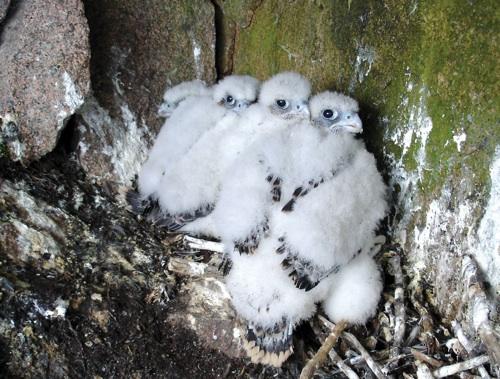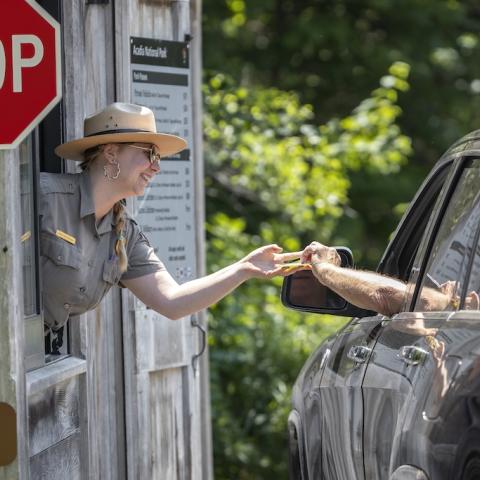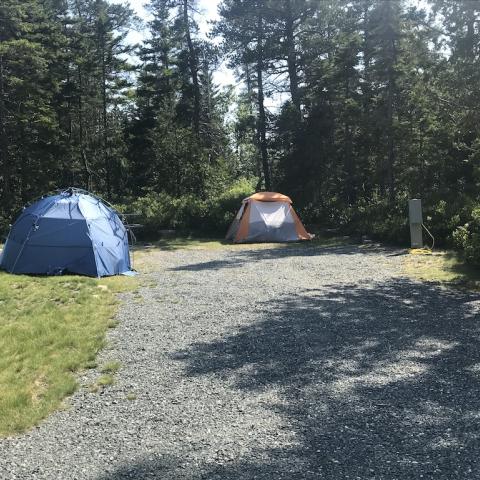
Peregrine falcons are returning to Acadia National Park for nesting/NPS
It's that time of year when peregrine falcons return to Acadia National Park in Maine for nesting, and that results in temporary closures of certain areas in the park.
The falcons are again defending nesting territories at the Precipice, Jordan, and Valley Cove cliffs in the park. Park staff has observed adults at these sites engaging in courtship and pre-nesting behavior signaling the birds’ intentions to nest and raise chicks during the spring and early summer. The National Park Service has closed the cliffs and associated trails to public entry to protect the peregrine falcons from inadvertent disturbance or harassment during the nesting period.
Research has shown that nesting peregrine falcons are particularly vulnerable to human activities, which can disturb the adults and make them less attentive to the eggs or chicks. Human activities near a nesting area can lead to temporary or permanent abandonment of the nest by the adults leaving chicks susceptible to hypothermia, starvation, and predation. Human disturbance that leads to chick mortality slows the recovery of this once endangered species.
“The success of peregrine falcon nesting in Acadia National Park is one of our great conservation stories,” said Superintendent Kevin Schneider. “We appreciate the cooperation of visitors in protecting peregrine falcons by complying with the temporary closures.”
The Jordan Cliffs Trail, Valley Cove Trail, Precipice Trail, and a portion of the Orange & Black Path are closed to public entry until further notice. Signs at trailheads and trail junctions around the closed areas indicate where public entry is prohibited. The reopening of the closed areas is expected by mid-August if nesting attempts succeed or possibly sooner if nesting attempts fail.
Public entry into a closed area is a violation of federal regulations, which is punishable by a fine, imprisonment, or both. Peregrine falcons generally reach breeding maturity at two years of age.
In Acadia, peregrine falcons nest on ledges and in small shallow caves located high on cliff walls. Typically, the male arrives at a nesting site and begins a series of aerial acrobatic displays to attract a mate. Peregrine falcons lay their eggs in “scrapes,” which are shallow indentations that they scratch out with their talons in soft earth on the floor of their nests. An average clutch of four eggs is laid in the spring and hatch about a month later.

Peregrine falcon chicks at Acadia National Park/NPS
Peregrine falcons vigorously defend their nests, but they may abandon a nest if disturbed. Studies in the 1930s and 1940s estimated that there were about 500 breeding pairs of peregrine falcons in the eastern United States and about 1,000 pairs in the West and Mexico. Beginning in the late 1940s, peregrine falcons suffered a devastating and rapid decline. By the mid-1960s, the species had been eliminated from nearly all of the eastern United States.
The U.S. Fish and Wildlife Service’s investigation of the peregrine falcon’s decline found unusually high concentrations of the pesticide DDT in their tissues, which accumulated by feeding on birds that had eaten DDT-contaminated insects or seeds. The toxic chemical interfered with eggshell formation resulting in eggs with shells so thin they often broke during incubation or otherwise failed to hatch. Because too few young were raised to replace adults that died, Peregrine falcon populations declined precipitously.
In 1970, the American and Arctic peregrine falcons subspecies were listed as endangered under the Endangered Species Act of 1969 (the law preceding the Endangered Species Act of 1973) reflecting their critical biological status under a cooperative effort among the USFWS, state wildlife agencies, and private organizations, more than 6,000 American peregrine falcons have been reintroduced since 1974.
Acadia National Park was selected as one of the recovery sites in Maine and began the recovery program in 1984 using a method known as hacking. This method places and rears young captive-bred peregrine falcons on suitable cliffs with the hope that the cliff and area is “imprinted” upon the young birds and that they return to the area as adults and establish a breeding population. Jordan Cliffs on the east side of Penobscot Mountain was selected as the original hack site and the first pair of peregrine falcons successfully nested there in 1991. Acadia’s nesting falcons have become a mainstay in the recovery of peregrine falcons in Maine with more than 125 chicks fledged since 1991.
In 1999, the USFWS removed the American peregrine falcon from the list of endangered and threatened species, marking one of the most dramatic successes of the Endangered Species Act. At that time, populations in most recovery regions of the United States had attained or surpassed most of the objectives identified in Regional Recovery Plans developed by states in concert with the USFWS. Recovered populations are being monitored through a national program that tracks the status of regional populations and reports when populations are not remaining stable or appear to be decreasing.
To learn more about peregrine falcons, and watch their nesting and fledging activities from a safe distance, visit this page or call 207-288-3338 for information on Acadia’s peregrine falcon watch program.




 Support Essential Coverage of Essential Places
Support Essential Coverage of Essential Places






